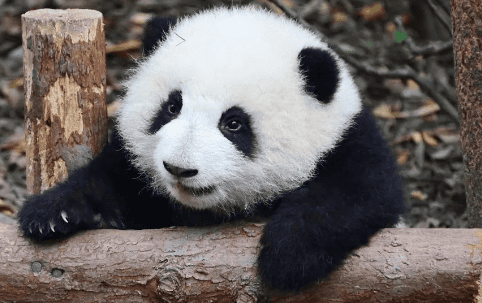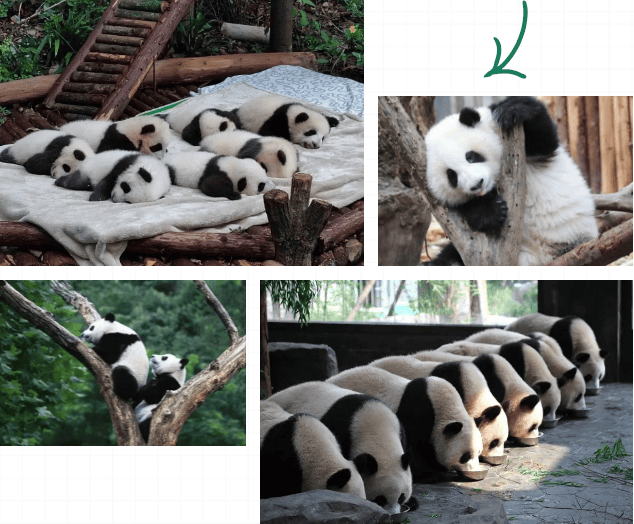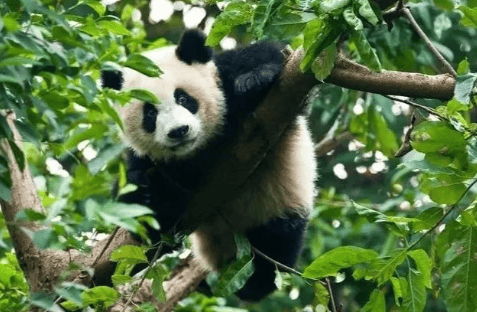The panda is a first-level protected animal in my country. As a "national treasure" that is loved by thousands of people, no one can refuse the panda's naive appearance. How much do you know about pandas?
#01 National Treasure Giant Panda

1. The top star in the animal world - the giant panda
The panda is a national first-level protected wild animal. It belongs to the Ursidae family and is a close relative of brown bears and polar bears. The body color is black and white, with round cheeks and large "dark circles" under the eyes. The history of giant pandas has a long history. About 8 million years old. Many animals of their time have become extinct, but giant pandas survive to this day and become living fossils.
2. Morphological characteristics
The body is plump and bear-like, with a round head and short tail. The head and body are 1.2-1.8 meters long, and the tail is 10-12 centimeters long. Weighing 80-120 kilograms, the heaviest can reach 180 kilograms. Raised pandas are slightly heavier, and generally male individuals are slightly larger than females. The hair color of the head and body is distinctly black and white, but the black is not pure black, and the white is not pure white, but black with brown and white with yellow.
3. Habitat
It lives in high mountains and deep valleys, with a cool and humid climate. The humidity is often above 80%. It is a moisture-loving animal. It likes places with lush forests, good bamboo growth, stable temperatures, good shelter, and abundant food and water resources.
#02 Its living habits

Eating Habits
Giant Panda The feeding habit is one of its most peculiar and interesting habits, because it lives almost entirely on bamboo, accounting for 99% of its annual food intake. Commonly eaten bamboo species in the wild include cold arrow bamboo, August bamboo, solid bamboo, Di bamboo, big leaf Di bamboo, Bashan wood bamboo, Huaju bamboo, etc. Commonly eaten bamboo species in captivity include spiny bamboo, white bamboo, light bamboo, bitter bamboo, cold arrow bamboo, arrow bamboo, three-month bamboo shoots, etc.
Scent Marking
Giant pandas communicate most through scent marks left in their habitat. Marking territory with scent is their secret to staying peaceful in the bamboo forest. During the non-estrus season, they will walk away as soon as they smell the scent of a strange panda. During the estrus season, they find each other through scent markings.
Behavioral Characteristics
Excluding half of the time for eating, the remaining half of the time is mostly spent in sleep. In the wild, giant pandas sleep for 2-4 hours between every two meals. Lying flat, sideways, prone, stretched or curled up are their preferred sleeping methods. The cutest features are its chubby body and the slow, piggy-back way it walks. He is also good at climbing trees and loves to play.
#03 Trivia about it

"National Treasure"
How long is the lifespan?
The average life span of giant pandas is about 25 years old. Under breeding conditions, the longest life span recorded for giant pandas exceeds 30 years old. A captive giant panda named "Dudu" in Wuhan Zoo has survived for 37 years, setting a world record.
How to reproduce?
A male giant panda can mate with multiple female giant pandas, and a female giant panda can also mate with multiple males. After mating is completed, the male and female giant pandas live separately again, and undergo pregnancy and childbirth. The work of raising and raising young is done by the female giant panda alone.
Will it bite?
Giant pandas can bite people. Although giant pandas are usually docile, if they are frightened, or feel pain, discomfort or uneasiness, they will bite suddenly when they have no way to escape. This is basically a conditioned reflex behavior.
Its "little secret"?
Myopia:
The vision of giant pandas is extremely underdeveloped. This is because giant pandas have lived in dense bamboo forests for a long time, with poor light and many obstacles, resulting in some myopia.
Walking pigeon-toed:
The giant panda’s pigeon-toed walking style. Because they live in an environment with plenty of food and no natural predators, this slow movement can also adapt to low-energy food.
Love to visit:
Pandas sometimes visit small villages or houses in mountain villages, treat pots, pots, buckets and utensils as toys, and then abandon them in the mountains after playing. Sometimes they also become friendly with domesticated livestock such as sheep and pigs, eating and living together.
Poop Master:
To get the nutrients you need, eat and poop as quickly as you want. An adult giant panda eats 30-38 kilograms of fresh bamboo shoots every day in spring and excretes more than 10 kilograms of feces.

 扫一扫微信交流
扫一扫微信交流
发布评论